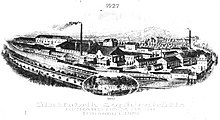Sophienhütte
The Sophienhütte was a glassworks that existed from 1852 to 1991 in Ilmenau (Thuringian Forest). For a long time it was the largest of the Ilmenau glassworks. In addition, its opening initiated the industrialization of the city as well as the tradition of the Ilmenau glass industry, which continues to this day. The Sophienhütte was the first successfully operated glassworks in Ilmenau. It was located on a large area in the south of the city, which stretched on the Ilm from the Ilmenau Bad train station in the west to the Kohlenberg (= the slag dump of the hut) in the east. Today there is a supermarket and the Ilm sports hall here.
history
To 1900
In 1851 the State Ministry of Saxony-Weimar-Eisenach granted the brothers Luis, Gustav and Alexander Küchler and the wood turner Johann Georg Abicht a license to build a hollow glass works in Ilmenau. The glassworks was named as a thank you to the ducal house for granting a concession after the wife of the reigning Duke Carl Alexander , Sophie von Orange-Nassau . The owners of the Sophienhütte obtained the wood for firing the blast furnaces from a specially purchased piece of wood from the Neustadt am Grenzhammer forestry office east of Ilmenau. The logging and transport were carried out by four families from Oehrenstock .
The main focus of production was on the manufacture of filigree perfume, medicine and medicine bottles until around 1860, before later they switched to mainly making technical tubular glass . Immediately after it was founded, around 40 people worked in the hut, most of whom were poached workers from the glassworks in Tettau ( Thuringian Slate Mountains ). Later one also trained new employees from the local population.
In 1881 Richard Bock bought the Sophienhütte from the Küchler brothers. At this point he was only 24 years old, but he managed the company so successfully that he was later appointed to the Council of Commerce by the Grand Duke . In 1883 a second hut building was put into operation on the company premises. It housed two new blast furnaces, one with 14 ports and one with six ports.
After 1900
The Rennsteigbahn was built in 1904 . It partly ran directly past the factory premises, so that Sophienhütte has been able to use a rail connection since then. At the same time, the Ilmenau Bad station was built directly at the Sophienhütte , for which an old slag dump from the glassworks had to be removed. Since then, the slag dump has been at the other end of the factory premises. In the course of time it piled up so far that it was popularly known as "Kohlenberg".
A third hut was opened in 1907. It contained a ten-port blast furnace. In 1910 the company had around 200 employees.
In 1922 the Sophienhütte was converted into a GmbH . The focus was now mainly on the production of technical hollow glasses as a starting material z. B. for thermometer production. Many of the approximately 800 different items were made with a special mixture of raw materials that was similar to the Jena glass invented by Otto Schott . At that time the Sophienhütte and the Schottschen Hütten in Jena were among the leading manufacturers of technical glass in Germany. Sophienhütte had 32 company agencies around the world to coordinate exports .
In 1938 around 280 people worked in the Sophienhütte. After 1945, the range was redesigned from technical glass to commercial glass. Until 1972 the Sophienhütte was a semi-state enterprise in the legal form of a limited partnership . It was completely nationalized and renamed “ Rosalinglaswerk ” in 1972. In 1983 it was renamed “ VEB Ilmkristall”. At that time it had around 270 employees. In addition to the Sophienhütte - the parent plant - VEB Ilmkristall also included VEB Glaswerk Schmiedefeld am Rennsteig , VEB Kunstglas Gehren and VEB Kunst- und Hohlglasveredelung Wasungen . The VEB Ilmkristall with its four operating parts was in turn part of the VEB Werk für Technisches Glas Ilmenau combine . At the end of the 1980s, the Sophienhütte packing house was demolished. It also housed the files from 140 years of inventory history, which were also destroyed at that time. After the upheavals of the fall of 1990, the Sophienhütte had to file for bankruptcy. It was shut down in 1991 and demolished in 1998. Today only its administration building is preserved.
literature
- Barbara Schramm: From the “Sophienhütte” glass factory to “Ilmkristall GmbH” (1852 to 1991) in Glas in Ilmenau . Friends of the Ilmenau Glass Museum eV, Ilmenau 1998.
Web links
Coordinates: 50 ° 40 ′ 53 ″ N , 10 ° 54 ′ 42 ″ E



